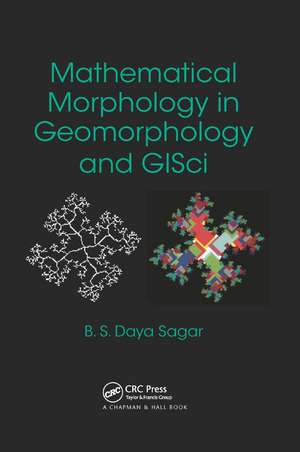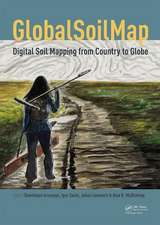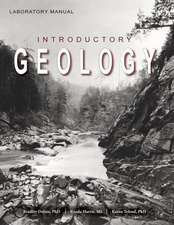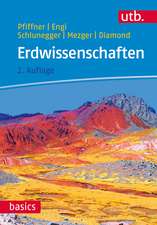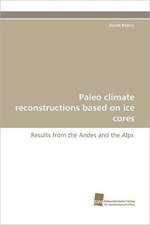Mathematical Morphology in Geomorphology and GISci
Autor Behara Seshadri Daya Sagaren Limba Engleză Paperback – 18 sep 2018
For understanding the spatiotemporal characteristics of terrestrial phenomena and processes, the author provides morphological approaches and algorithms to:
- Retrieve unique geomorphologic networks and certain terrestrial features
- Analyze various geomorphological phenomena and processes via a host of scaling laws and the scale-invariant but shape-dependent indices
- Simulate the fractal-skeletal-based channel network model and the behavioral phases of geomorphologic systems based on the interplay between numeric and graphic analyses
- Detect strategically significant sets and directional relationships via quantitative spatial reasoning
- Visualize spatiotemporal behavior and generate contiguous maps via spatial interpolation
| Toate formatele și edițiile | Preț | Express |
|---|---|---|
| Paperback (1) | 370.25 lei 6-8 săpt. | |
| CRC Press – 18 sep 2018 | 370.25 lei 6-8 săpt. | |
| Hardback (1) | 999.79 lei 6-8 săpt. | |
| CRC Press – 29 mai 2013 | 999.79 lei 6-8 săpt. |
Preț: 370.25 lei
Preț vechi: 477.20 lei
-22% Nou
Puncte Express: 555
Preț estimativ în valută:
70.85€ • 74.17$ • 58.62£
70.85€ • 74.17$ • 58.62£
Carte tipărită la comandă
Livrare economică 07-21 aprilie
Preluare comenzi: 021 569.72.76
Specificații
ISBN-13: 9781138374591
ISBN-10: 1138374598
Pagini: 546
Ilustrații: 216
Dimensiuni: 156 x 234 mm
Greutate: 0.45 kg
Ediția:1
Editura: CRC Press
Colecția Chapman and Hall/CRC
ISBN-10: 1138374598
Pagini: 546
Ilustrații: 216
Dimensiuni: 156 x 234 mm
Greutate: 0.45 kg
Ediția:1
Editura: CRC Press
Colecția Chapman and Hall/CRC
Public țintă
Professional Practice & DevelopmentCuprins
Introduction. Mathematical Morphology: An Introduction. Simulated, Realistic Digital Elevation Models, Digital Bathymetric Maps, Remotely Sensed Data, and Thematic Maps. Feature Extraction. Terrestrial Surface Characterization: A Quantitative Perspective. Size Distributions, Spatial Heterogeneity, and Scaling Laws. Morphological Shape Decomposition: Scale-Invariant but Shape-Dependent Measures. Granulometries, Convexity Measures, and Geodesic Spectrum for DEM Analyses. Synthetic Examples to Understand Spatiotemporal Dynamics of Certain Geo(morpho)logical Processes. Quantitative Spatial Relationships and Spatial Reasoning. Derivation of Spatially Significant Zones from a Cluster. Directional Spatial Relationship. "Between" Space. Spatial Interpolations. Index.
Notă biografică
B.S. Daya Sagar is an associate professor at the Indian Statistical Institute, Bangalore, where he is also the founding head of the Systems Science and Informatics Unit. He has written more than 80 papers and is the editor of Discrete Dynamics in Nature and Society: Multidisciplinary Research and Review Journal. Dr. Sagar is a senior member of the IEEE Geoscience and Remote Sensing Society; a member of the New York Academy of Sciences, American Geophysical Union, International Association for Mathematical Geosciences, and Association for Computing Machinery; and a fellow of the Royal Geographical Society and Indian Geophysical Union. He has been a recipient of several honors, including the Georges Matheron Award from the International Association for Mathematical Geosciences. His research interests include mathematical morphology and fractal geometry and their applications to terrestrial surface and associated features as well as geomorphologic information retrieval, quantitative geomorphometry, allometry, granulometry, scaling analysis, quantitative spatial reasoning, and spatiotemporal modeling.
Recenzii
"I am sure that this very dense and useful work will appeal to geomorphologists, structural geologists, and geographers open to new research ideas and approaches. They will find in this book a rich source of inspiration for their own research that, I expect, will foster their desire to deepen their knowledge of mathematical morphology. As a mathematical morphologist myself, I found the many case studies presented stimulating … this book can also be considered as an efficient instrument of dialogue, a bridge between image processing and geosciences, giving rise to fruitful discussions and exchanges about emerging issues and possible solutions, thereby contributing to disseminate mathematical morphology. Thanks to Daya Sagar!"
— Serge Beucher, Mathematical Geosciences, 2014
"… invaluable. All the basic concepts of mathematical morphology, as originally defined by Matheron and Serra in the 1970s and later extended by many authors, are clearly presented with many practical examples of how to use them. As Professor Sagar has himself largely contributed to the modern theory of geomorphology, his book is rich in new concepts and methods. Hydrologists will be happy to find that many of the examples given in the book deal with rivers, water bodies, and the morphology of drainage basins."
—Ghislain de Marsily, Université Paris 6, French Academy of Sciences
"This work was written by a well-known geomorphology expert, Daya Sagar, for other geomorphology experts. Knowledge in geomorphology and geographic information systems is required to be able to follow the material. … introduces all the formulas for the mathematical morphology. The author describes every operator in detail, with many examples. … provides solid information about using mathematical morphology for geographic imaging from a real expert in the field."
—Jose Manuel Palomares Munoz, ACM Computing Reviews
"… this book is a truly remarkable contribution that is likely to make a significant impact in the GISci community far beyond its primary target audience of geomorphologists. Mathematical Morphology in Geomorphology and GISci is also a celebration of the remarkably innovative contributions of Daya Sagar over the last two decades."
—Nigel Waters, Geomatica, vol. 67, no. 4, 2013
"[The author] shows how mathematical morphology could be used to deal with the quantitative morphologic and scaling analyses of terrestrial phenomena and processes. After introducing mathematical morphology as an advanced spatial statistical tool that is popular in image processing and analysis, he discusses such topics as feature extraction, morphological shape decompostions, directional spatial relationship, and spatial interpolations."
—Book News Inc., 2013
"The new book addressing the application of mathematical morphology to problems in geomorphology by Dr. B.S. Daya Sagar is timely and fills a needed gap. Dr. Sagar is one of the world’s leading experts on mathematical morphology. This book is large but well organized and clearly written. It is accessible to those with no knowledge of mathematical morphology, as early chapters introduce the basic structuring elements and provide numerous examples. There are practical examples throughout the book and the theoretical underpinnings are tied to examples. As a statistician, I found the quantitative spatial relationships and reasoning especially interesting. Many of us educated in North America perhaps may have had limited exposure to this subject but it merits serious consideration, given the importance of spatial-temporal relationships and clustering."
—John H. (Jack) Schuenemeyer, President, Southwest Statistical Consulting, LLC
"Professor Daya Sagar’s book is a triumph in the literature on morphology. It provides rich, comprehensive insight into the mathematics of morphology, using problems and examples from the geographic sciences. In addition, scholars of image processing, computer vision, and medical imagery will also find useful material in shape analysis and recognition."
—Kentaro Toyama, University of California, Berkeley
"Professor Daya Sagar’s book is a tour de force. He approaches mathematical morphology in depth from a variety of perspectives and practitioners and researchers from many fields will find much to learn. His linking of pattern retrieval, pattern analysis and modelling is innovative and powerful."
—Sir Alan Wilson, University College London
"A wide-ranging treatise by an erudite scholar."
—Jayanth Banavar, University of Maryland
"This book attacks the deep problem of analyzing mathematically the form of landscapes by mathematical tools, in particular by involving the discipline founded by geoscientists Matheron and Serra: mathematical morphology. The approach is original and pedagogic. It systematically combines experiments on numerical synthetic landscape models with experiments on real digital elevation models. Some chapters are very original, as they aim at the explanation of complex geomorphological phenomena. For example, the formation of dunes is explored by its underlying bifurcation theory."
—Jean-Michel Morel, Ecole Normale Supérieure de Cachan, CMLA, France
"… describes several techniques of mathematical morphology to address problems of image processing and data analysis with applications in geophysical information retrieval, analysis, reasoning, and modeling. … provides not only details of various techniques of mathematical morphology, but also several illustrations of application. … One of several novel aspects of the book is the integration of mathematical morphology and fractal analysis. … contains extensive discussion and illustration of many more applications of image and data analysis in geomorphology and geographic information science. Coming from a different background in biomedical signal and image analysis, I find the illustrations and examples provided in the book to be not only interesting but also attractive and intriguing. The detailed procedures described in the book along with the large number of illustrations of application should assist researchers and practitioners in geographic information science and other areas of application of image processing and data analysis."
—Rangaraj M. Rangayyan, University of Calgary
"This book represents an interesting application of approaches of mathematical morphology to digital terrain modelling."
—Igor Florinsky, Russian Academy of Sciences
"… a welcome addition to the literature. It fills a gap that has existed for some time in the field of image analysis by providing a comprehensive mathematically based overview of methods to systematically analyze the great variety of features observed at the surface of the Earth. … The author has included numerous instructive examples of application with a substantial number of them related to the analysis of fractal patterns. Overall, the treatment of the subjects is thorough and the book can be regarded as a follow-up to the original approach to mathematical morphology commenced by Georges Matheron in the 1970s and 1980s. … The author offers excellent explanations and examples of application of non-linear process modelling … I also highly recommend this new book to all teachers engaged in presenting courses on geomorphology and GISci to university students."
—Frits Agterberg, Geological Survey of Canada
"This enticing book introduces mathematical morphology to GI scientists in a way that is persuasive and accessible using ideas that the author himself has pioneered in the last 20 years. It should be read by all those with an interest in how we represent surfaces in the environmental and urban domain.
What is so appealing about this book is that the author introduces geomorphology using models of mathematical structure that are rooted in new approaches to geometry, particularly fractals and chaos. He adopts a basic model of a fractal river basin from which he extracts skeletal structures, thereby introducing ideas about networks in the landscape in an entirely natural way. He uses this as a basis for developing many other aspects of mathematical morphology—the use of sets to generate partitions of areas, the use of interpolation to produce surface representations, and the identification of spatial clusters. Towards the end of the book, he generalises many of these ideas to more human spatial systems using the regionalisation of India as his exemplar and in so doing, he has produced as comprehensive a treatment of morphology in geographic information science as you will find anywhere. This is an important book that should be explored by all those who profess to be interested in spatial morphologies."
—Michael Batty, University College London
"Since the initial birthing of computational geography and GIS over fifty years ago, the field of geography has been evolving with many contributions from both the academic and research side as well as the application world. I am happy to see the emergence of Mathematical Morphology in Geomorphology and GISci. This text further extends our understanding of GIScience—how fundamental quantitative approaches can extend how we understand geography and our world."
—Jack Dangermond, President, Esri
"This is a unique book on the analysis of various geomorphology problems using mathematical morphology. The author is an acknowledged expert on the subject and this specialized book is the outcome of over 15 years of continued research by him. Spreading over more than 500 pages in 14 chapters, the book elaborately deals with feature extraction, analysis, reasoning, and modeling of spatio-temporal terrestrial data. The topics are described in a lucid manner with many examples and figures, making them easy to understand. Though primarily aimed for geomorphologists, this book will be helpful for researchers working in problems of geography, cartography, geology, remote sensing, and pattern recognition."
—Bidyut B. Chaudhuri, Indian Statistical Institute
"The monograph provides, in a consolidated manner, an application of mathematical morphology to structural geology, particularly addressing the issues like quantitative, morphologic, and scaling analyses to terrestrial phenomena and processes. Texts on retrieval, modeling, and reasoning, for example, are also useful to other application domains related to machine learning and pattern analysis."
—Sankar K. Pal, Indian Statistical Institute
"Prof. Daya Sagar is a leading authority who has made major research contributions in most aspects of the applications of mathematical morphology and fractal geometry in terrestrial geomorphology and spatial informatics. This unique book—highlighted with numerous cases for those interested in developing physics-based models useful in geocomputation and spatial informatics—takes an algorithmic approach to efficiently handle topics related to (i) retrieval of complex terrestrial phenomena, (ii) analysis and reasoning of such retrieved phenomena, (iii) modeling and visualization of various terrestrial processes, and (iv) spatial informatics. The choice of the author to combine mathematical morphology and fractal geometry, being the most powerful ideas in a geometric sense, is perfectly right and appropriate for quantitative characterization of terrestrial phenomena and processes that exhibit plethora of geometric features and processes ranging from ‘simple’ to ‘strange.’"
—B.L. Deekshatulu, Institute for Development and Research in Banking Technology
"… considers various topics—like pattern retrieval, pattern analysis, spatial reasoning, and simulation and modeling—of geoscientific interest. … these intertwined topics, which are useful for understanding the spatiotemporal behaviour of many terrestrial phenomena and processes, various original algorithms, and modelling techniques that are mainly based on mathematical morphology, fractal geometry, and chaos theory, have been presented in this book of 14 chapters. ... the journey through this book should provide geomorphologists and GISci specialists a new experience and exposition, and a host of new ideas to explore further in the contexts of quantitative geomorphology and spatial reasoning. … book should be of immense value to the postgraduates, doctoral, and post-doctoral students who would like to venture into applications of mathematical morphology in geomorphology and GISci."
—From the Afterword by Arthur P. Cracknell, University of Dundee
"… great care is taken in introducing the morphological notions in a pedagogical way. … the numerous examples will allow engineers and researchers in structural geology to exercise their creative faculties and to find new formulations of their own problems."
—From the Foreword by Jean Serra, Université Paris-Est
— Serge Beucher, Mathematical Geosciences, 2014
"… invaluable. All the basic concepts of mathematical morphology, as originally defined by Matheron and Serra in the 1970s and later extended by many authors, are clearly presented with many practical examples of how to use them. As Professor Sagar has himself largely contributed to the modern theory of geomorphology, his book is rich in new concepts and methods. Hydrologists will be happy to find that many of the examples given in the book deal with rivers, water bodies, and the morphology of drainage basins."
—Ghislain de Marsily, Université Paris 6, French Academy of Sciences
"This work was written by a well-known geomorphology expert, Daya Sagar, for other geomorphology experts. Knowledge in geomorphology and geographic information systems is required to be able to follow the material. … introduces all the formulas for the mathematical morphology. The author describes every operator in detail, with many examples. … provides solid information about using mathematical morphology for geographic imaging from a real expert in the field."
—Jose Manuel Palomares Munoz, ACM Computing Reviews
"… this book is a truly remarkable contribution that is likely to make a significant impact in the GISci community far beyond its primary target audience of geomorphologists. Mathematical Morphology in Geomorphology and GISci is also a celebration of the remarkably innovative contributions of Daya Sagar over the last two decades."
—Nigel Waters, Geomatica, vol. 67, no. 4, 2013
"[The author] shows how mathematical morphology could be used to deal with the quantitative morphologic and scaling analyses of terrestrial phenomena and processes. After introducing mathematical morphology as an advanced spatial statistical tool that is popular in image processing and analysis, he discusses such topics as feature extraction, morphological shape decompostions, directional spatial relationship, and spatial interpolations."
—Book News Inc., 2013
"The new book addressing the application of mathematical morphology to problems in geomorphology by Dr. B.S. Daya Sagar is timely and fills a needed gap. Dr. Sagar is one of the world’s leading experts on mathematical morphology. This book is large but well organized and clearly written. It is accessible to those with no knowledge of mathematical morphology, as early chapters introduce the basic structuring elements and provide numerous examples. There are practical examples throughout the book and the theoretical underpinnings are tied to examples. As a statistician, I found the quantitative spatial relationships and reasoning especially interesting. Many of us educated in North America perhaps may have had limited exposure to this subject but it merits serious consideration, given the importance of spatial-temporal relationships and clustering."
—John H. (Jack) Schuenemeyer, President, Southwest Statistical Consulting, LLC
"Professor Daya Sagar’s book is a triumph in the literature on morphology. It provides rich, comprehensive insight into the mathematics of morphology, using problems and examples from the geographic sciences. In addition, scholars of image processing, computer vision, and medical imagery will also find useful material in shape analysis and recognition."
—Kentaro Toyama, University of California, Berkeley
"Professor Daya Sagar’s book is a tour de force. He approaches mathematical morphology in depth from a variety of perspectives and practitioners and researchers from many fields will find much to learn. His linking of pattern retrieval, pattern analysis and modelling is innovative and powerful."
—Sir Alan Wilson, University College London
"A wide-ranging treatise by an erudite scholar."
—Jayanth Banavar, University of Maryland
"This book attacks the deep problem of analyzing mathematically the form of landscapes by mathematical tools, in particular by involving the discipline founded by geoscientists Matheron and Serra: mathematical morphology. The approach is original and pedagogic. It systematically combines experiments on numerical synthetic landscape models with experiments on real digital elevation models. Some chapters are very original, as they aim at the explanation of complex geomorphological phenomena. For example, the formation of dunes is explored by its underlying bifurcation theory."
—Jean-Michel Morel, Ecole Normale Supérieure de Cachan, CMLA, France
"… describes several techniques of mathematical morphology to address problems of image processing and data analysis with applications in geophysical information retrieval, analysis, reasoning, and modeling. … provides not only details of various techniques of mathematical morphology, but also several illustrations of application. … One of several novel aspects of the book is the integration of mathematical morphology and fractal analysis. … contains extensive discussion and illustration of many more applications of image and data analysis in geomorphology and geographic information science. Coming from a different background in biomedical signal and image analysis, I find the illustrations and examples provided in the book to be not only interesting but also attractive and intriguing. The detailed procedures described in the book along with the large number of illustrations of application should assist researchers and practitioners in geographic information science and other areas of application of image processing and data analysis."
—Rangaraj M. Rangayyan, University of Calgary
"This book represents an interesting application of approaches of mathematical morphology to digital terrain modelling."
—Igor Florinsky, Russian Academy of Sciences
"… a welcome addition to the literature. It fills a gap that has existed for some time in the field of image analysis by providing a comprehensive mathematically based overview of methods to systematically analyze the great variety of features observed at the surface of the Earth. … The author has included numerous instructive examples of application with a substantial number of them related to the analysis of fractal patterns. Overall, the treatment of the subjects is thorough and the book can be regarded as a follow-up to the original approach to mathematical morphology commenced by Georges Matheron in the 1970s and 1980s. … The author offers excellent explanations and examples of application of non-linear process modelling … I also highly recommend this new book to all teachers engaged in presenting courses on geomorphology and GISci to university students."
—Frits Agterberg, Geological Survey of Canada
"This enticing book introduces mathematical morphology to GI scientists in a way that is persuasive and accessible using ideas that the author himself has pioneered in the last 20 years. It should be read by all those with an interest in how we represent surfaces in the environmental and urban domain.
What is so appealing about this book is that the author introduces geomorphology using models of mathematical structure that are rooted in new approaches to geometry, particularly fractals and chaos. He adopts a basic model of a fractal river basin from which he extracts skeletal structures, thereby introducing ideas about networks in the landscape in an entirely natural way. He uses this as a basis for developing many other aspects of mathematical morphology—the use of sets to generate partitions of areas, the use of interpolation to produce surface representations, and the identification of spatial clusters. Towards the end of the book, he generalises many of these ideas to more human spatial systems using the regionalisation of India as his exemplar and in so doing, he has produced as comprehensive a treatment of morphology in geographic information science as you will find anywhere. This is an important book that should be explored by all those who profess to be interested in spatial morphologies."
—Michael Batty, University College London
"Since the initial birthing of computational geography and GIS over fifty years ago, the field of geography has been evolving with many contributions from both the academic and research side as well as the application world. I am happy to see the emergence of Mathematical Morphology in Geomorphology and GISci. This text further extends our understanding of GIScience—how fundamental quantitative approaches can extend how we understand geography and our world."
—Jack Dangermond, President, Esri
"This is a unique book on the analysis of various geomorphology problems using mathematical morphology. The author is an acknowledged expert on the subject and this specialized book is the outcome of over 15 years of continued research by him. Spreading over more than 500 pages in 14 chapters, the book elaborately deals with feature extraction, analysis, reasoning, and modeling of spatio-temporal terrestrial data. The topics are described in a lucid manner with many examples and figures, making them easy to understand. Though primarily aimed for geomorphologists, this book will be helpful for researchers working in problems of geography, cartography, geology, remote sensing, and pattern recognition."
—Bidyut B. Chaudhuri, Indian Statistical Institute
"The monograph provides, in a consolidated manner, an application of mathematical morphology to structural geology, particularly addressing the issues like quantitative, morphologic, and scaling analyses to terrestrial phenomena and processes. Texts on retrieval, modeling, and reasoning, for example, are also useful to other application domains related to machine learning and pattern analysis."
—Sankar K. Pal, Indian Statistical Institute
"Prof. Daya Sagar is a leading authority who has made major research contributions in most aspects of the applications of mathematical morphology and fractal geometry in terrestrial geomorphology and spatial informatics. This unique book—highlighted with numerous cases for those interested in developing physics-based models useful in geocomputation and spatial informatics—takes an algorithmic approach to efficiently handle topics related to (i) retrieval of complex terrestrial phenomena, (ii) analysis and reasoning of such retrieved phenomena, (iii) modeling and visualization of various terrestrial processes, and (iv) spatial informatics. The choice of the author to combine mathematical morphology and fractal geometry, being the most powerful ideas in a geometric sense, is perfectly right and appropriate for quantitative characterization of terrestrial phenomena and processes that exhibit plethora of geometric features and processes ranging from ‘simple’ to ‘strange.’"
—B.L. Deekshatulu, Institute for Development and Research in Banking Technology
"… considers various topics—like pattern retrieval, pattern analysis, spatial reasoning, and simulation and modeling—of geoscientific interest. … these intertwined topics, which are useful for understanding the spatiotemporal behaviour of many terrestrial phenomena and processes, various original algorithms, and modelling techniques that are mainly based on mathematical morphology, fractal geometry, and chaos theory, have been presented in this book of 14 chapters. ... the journey through this book should provide geomorphologists and GISci specialists a new experience and exposition, and a host of new ideas to explore further in the contexts of quantitative geomorphology and spatial reasoning. … book should be of immense value to the postgraduates, doctoral, and post-doctoral students who would like to venture into applications of mathematical morphology in geomorphology and GISci."
—From the Afterword by Arthur P. Cracknell, University of Dundee
"… great care is taken in introducing the morphological notions in a pedagogical way. … the numerous examples will allow engineers and researchers in structural geology to exercise their creative faculties and to find new formulations of their own problems."
—From the Foreword by Jean Serra, Université Paris-Est
Descriere
This book presents a multitude of mathematical morphological approaches for processing and analyzing digital images in quantitative geomorphology and geographic information science (GISci). Covering many interdisciplinary applications, the book explains how to use mathematical morphology not only to perform quantitative morphologic and scaling analyses of terrestrial phenomena and processes, but also to deal with challenges encountered in quantitative spatial reasoning studies. Easy-to-understand equations, straightforward explanations, and clear illustrations allow readers without a background in mathematical morphology to understand the material and implement the ideas.
